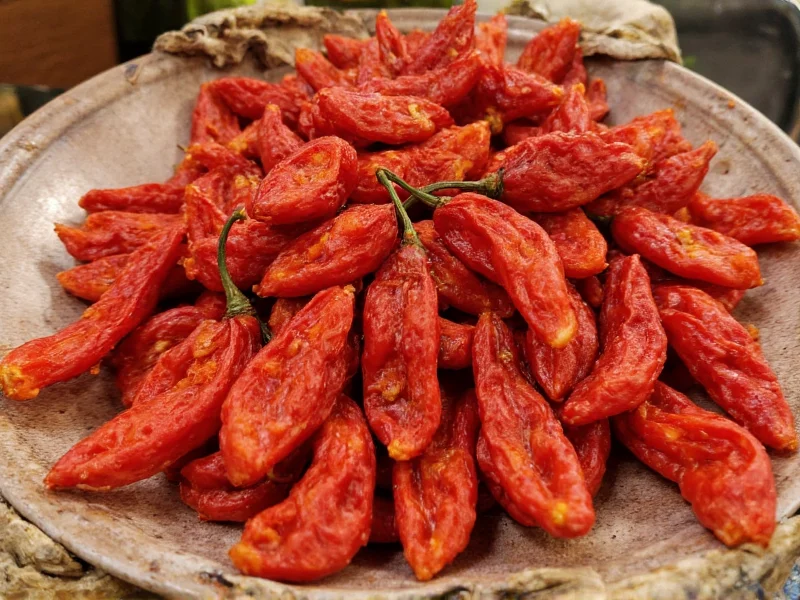Dried serrano peppers represent a versatile pantry staple that transforms the familiar fresh serrano into a concentrated flavor powerhouse. When serrano peppers reach full maturity and undergo dehydration, they develop a distinctive culinary profile that differs significantly from their fresh form. This transformation makes them valuable for specific cooking applications where depth of flavor and controlled heat are essential.
Understanding the Drying Process and Its Effects
The drying process fundamentally alters serrano peppers' chemical composition. As moisture evaporates, capsaicinoids—the compounds responsible for heat—become more concentrated, while natural sugars caramelize, creating complex flavor notes. Unlike fresh serranos with their bright, grassy notes, dried versions develop earthy, smoky characteristics with subtle fruit undertones.
Properly dried serrano peppers should maintain a deep green to dark olive color, though some browning is normal. The texture becomes brittle and papery, allowing for easy crumbling or grinding. This physical transformation directly impacts how chefs incorporate them into dishes, as dried serranos require rehydration or grinding before use in most applications.
Flavor Profile and Heat Characteristics
Dried serrano peppers register between 10,000-23,000 Scoville Heat Units (SHU), making them significantly hotter than jalapeños but milder than habaneros. The drying process intensifies their heat while mellowing their fresh pepper sharpness. Their flavor profile features:
- Primary notes: Earthy, smoky, with subtle woodsy undertones
- Secondary characteristics: Mild fruitiness, slight bitterness
- Aftertaste: Clean heat that builds gradually without overwhelming other flavors
| Pepper Type | Scoville Range | Flavor Profile | Best Culinary Uses |
|---|---|---|---|
| Dried Serrano | 10,000-23,000 SHU | Earthy, smoky, subtle fruitiness | Salsas, moles, spice rubs, stews |
| Fresh Serrano | 8,000-22,000 SHU | Grassy, bright, vegetal | Pico de gallo, fresh salsas, garnishes |
| Dried Arbol | 15,000-30,000 SHU | Nutty, slightly smoky | Hot sauces, vinegar infusions |
| Dried Chipotle | 2,500-8,000 SHU | Smoky, sweet, tobacco-like | Barbecue sauces, braises, bean dishes |
Practical Culinary Applications
Professional chefs and home cooks utilize dried serrano peppers in specific applications where their concentrated flavor shines. The most effective dried serrano pepper uses include:
Rehydration Techniques
For applications requiring whole or sliced peppers, proper rehydration preserves flavor integrity:
- Place dried serranos in a heatproof bowl
- Cover with just-boiled water or broth
- Weight down with a small plate to keep submerged
- Steep for 15-20 minutes until pliable but not mushy
- Reserve soaking liquid for additional flavor
The rehydration liquid captures soluble flavors and should be incorporated into sauces or stews. For dried serrano substitution ratio calculations, use 1 dried pepper equals 2-3 fresh serranos by volume, adjusting for desired heat level.
Grinding and Powder Creation
Dried serranos excel when transformed into powder. For optimal results:
- Toast whole dried peppers in a dry skillet for 30-60 seconds
- Cool completely before grinding
- Use a dedicated spice grinder for finest texture
- Sift powder to remove fibrous bits
- Store in airtight container away from light
This homemade dried serrano powder offers superior flavor to commercial versions, with no additives. It provides precise heat control for seasoning meats, vegetables, or finishing dishes.
Storage Guidelines for Maximum Freshness
Proper storage maintains dried serrano quality for extended periods. Follow these guidelines for storing dried serrano peppers:
- Store in airtight glass containers away from light and heat
- Include a food-safe desiccant packet to control moisture
- Keep in a cool, dark pantry (not the refrigerator)
- Whole peppers last 1-2 years; ground powder 6-8 months
- Check periodically for moisture or mold development
Signs of deterioration include darkening color, musty odor, or soft spots. Properly stored dried serranos maintain their characteristic heat level and develop more complex flavors over the first 3-6 months before gradually diminishing.
Comparing Dried Serrano to Similar Varietals
Understanding how dried serrano compares to other dried chilies helps in recipe development. While dried serrano vs chipotle shows significant differences in heat and flavor profile, the comparison with dried arbol reveals closer heat levels but distinct flavor characteristics.
Dried serrano vs fresh serrano presents the most dramatic transformation—fresh versions offer bright, grassy notes suitable for raw applications, while dried versions provide deeper, more complex flavors ideal for cooked dishes. The drying process concentrates capsaicin, making dried serranos approximately 25% hotter by weight than their fresh counterparts.
Expert Tips for Home Cooks
Professional chefs recommend these techniques when working with dried serrano peppers:
- Always wear gloves when handling dried chilies to prevent skin irritation
- Toast whole dried peppers briefly before rehydrating to enhance flavor complexity
- Add dried serrano early in cooking for integrated heat, or later for brighter pepper notes
- Balance the heat with acidic components like lime juice or vinegar
- Start with less than you think you need—you can always add more heat
For those exploring dried serrano pepper uses in traditional Mexican cooking, they're essential in certain regional moles and adobo sauces where their specific heat profile and flavor notes create authentic results that other chilies cannot replicate.











 浙公网安备
33010002000092号
浙公网安备
33010002000092号 浙B2-20120091-4
浙B2-20120091-4